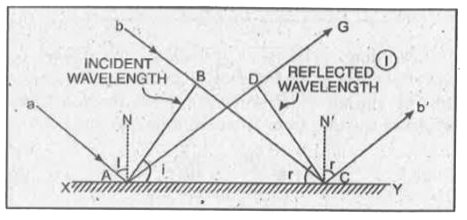State Huygens' principle and prove the laws of reflection on the basis of wave theory.
Text Solution
Laws of reflection
(i) Ist Law. It states that angle of incidence is equal to angle of reflection.
(ii) 2nd Law. It states that the incident ray, the reflected ray and the normal, at the point of incidence all lie in the same plane.
First law of reflection. Let XY be a plane reflecting surface and AB be a plane wavefront incident on the surface as shown in the figure.
According to Huygens. principle, every point on wavefront AB is a source of secondary wavelets and the time during which wavelet from B reaches at C, the reflected wavelet from A would arrive at D.

i.e. t=BCv=ADv
or BC = AD, ...(i)
where v is the velocity of light in the medium.
In rt ∠ΔABC ,
sini=BCAC
or BC=ACsini ...(ii)
In rt ∠ΔADC,sinr=ADAC
or AD = AC sin r ...(iii)
Putting Eqs, (ii) and (iii) in (i), we get
AC sin i =AC sin r
or sin i = sin r
or i = r
i.e: Angle of incidence = angle of reflection
This is first law of reflection.
Second law of reflection. From the figure, we find that, the incident ray, the reflected ray and the normal all lie on the same plane XY. This proves second law of reflection.
|
Topper's Solved these Questions
- OPTICSBOOK - MBD -HARYANA BOARDCHAPTER - OPTICSEXERCISE - LONG ANSWER TYPE QUESTIONS
18 Videos
- OPTICSBOOK - MBD -HARYANA BOARDCHAPTER - OPTICSEXERCISE - OBJECTIVE TYPE QUESTIONS
26 Videos
- OPTICSBOOK - MBD -HARYANA BOARDCHAPTER - OPTICSEXERCISE - OBJECTIVE TYPE QUESTIONS
26 Videos
- MODEL TEST PAPER - 2BOOK - MBD -HARYANA BOARDCHAPTER - MODEL TEST PAPER - 2EXERCISE - SET - D ( LONG ANSWER TYPE QUESTIONS)
4 Videos
- PRINCIPLES OF COMMUNICATIONBOOK - MBD -HARYANA BOARDCHAPTER - PRINCIPLES OF COMMUNICATIONEXERCISE - Objective Type Questions
19 Videos
Similar Questions
Knowledge Check
Huygen's principle states that
Awave is transverse waveBeach point of the wavefront is in different phaseCeach point of the wavefront acts as secondary sourceDall of theseHuygen's principle of secondary waves
Aallows us to find the focal length of a thick lensBgives us the magnifying power of a microscopeCis a geometrical method to find the position of a wavefrontDis used to determine the velocity of lifgt
Using Huygens' principle, establish the law of reflection.
View SolutionDefine the term wavefront. Using Huygens' wave theory, verify the laws of reflection.
View SolutionDefine a wavefront . Using Huygens principle ,verify the laws of reflection at a plane surface.
View SolutionDefine a wavefront. Using Huygen's principle, verifyi the laws of reflection at a plane surface.
View SolutionWave Front|Huygen's Principle
View SolutionUsing Huygen.s principle, verify Snell.s law of refraction of plane wave propagating from denser medium to rarer medium.
View Solution
